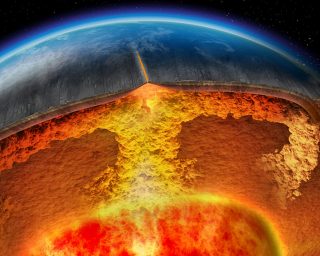Early whole mantle remixing suggests a start of global plate tectonics before three billion years ago
Earth is the only habitable planet we know so far, owing largely to its unique plate tectonic process that have been operative for at least much of the last billion years. However, when plate tectonics started remains controversial amongst the science community since the conception of the theory over 50 years ago. Some scientists believe it is applicable only for the past 800 million years or so, whereas others believe that it goes back as far as over four billion years, i.e., soon after the formation of the planet.
So far the evidence used in this debate almost all came from scarcely preserved surface geological proxies, and little attention has been paid to the record kept by Earth’s deep mantle, which is expected to have experienced a severe “stiring up” by the recycling of tectonic plates back into the mantle when plate tectonics started to operate in a global scale.
Aiming to take a more direct route to address this question, researchers from Curtin University’s Earth Dynamics Research Group in the School of Earth and Planetary Sciences recently reported their new findings based on a re-analysis of sudden changes in the chemical characteristics of rocks derived from the Earth’s mantle (called basalts and komatiites) globally back in time. The work, published in a paper in Nature series journal Scientific Reports led by Ph.D. student Mr. Hamed Gamal El Dien, found that after the initial chemical stratification and formation of a hard shell in the first billion years of our planet’s 4.5 billion year history, there was a major chemical ‘stir-up’ (a step-change in mantle composition) of the planet by sinking cold slabs from the surface some 3.2 billion years ago. This step-change is interpreted to reflect the start of global plate tectonic processes by that time.
Mr Gamal El Dien explains that during the earliest stages of Earth’s planetary differentiation, Earth was divided into three main layers which are the core, the mantle, and the crust. This chemical and gravitational differentiation process produced a mantle depleted in lighter elements, and an increasingly larger continental crust enriched in such elements. The Earth’s mantle is the second, and thickest, layer (84 % of Earth’s volume and 2900 kilometer thick).
If such lighter crustal materials are found to have been re-introduced back into the mantle, particularly into the lower mantle, such changes would be reflected in melts formed at different levels of the mantle and preserved in rocks exposed to the surface now. The wide occurrence of such mantle re-enrichment in a global scale would suggest the operation of plate tectonics, where the subducting cold slabs bring such light elements back into the deep mantle.
To complete this research, the team looked at the time variation of the isotopic and chemical composition of about 6,000 mantle-derived rocks (basaltic and komatiitic lavas), erupted from continents and the ocean floors between two and four billion years ago.
The researchers demonstrate that a significant shift in mantle composition started around 3.2 billion years ago, indicating a global recycling of crustal materials back into Earth’s mantle via subduction at this time. Thus pinpointing the onset of global subduction processes and the operation of plate tectonics.
Basaltic and komatiitic lavas are believed to be derived from the upper and lower mantle, respectively. This research demonstrates, for the first time, that a global change in the composition of komatiitic lavas occurred at 3.2 billion years ago, suggesting that subduction reached the deep lower mantle at this time.

Contact person: Mr Hamed Gamal El Dien & Prof Zheng-Xiang Li, Earth Dynamics Research Group, Curtin University.
Relevant publication:
Gamal EL Dien, H., Doucet, L.S., Murphy, J.B., Li, Z.-X., 2020. Geochemical evidence for a widespread mantle re-enrichment 3.2 billion years ago: implications for global-scale plate tectonics. Scientific Reports, 10, 9461. https://doi.org/10.1038/s41598-020-66324-y
Read the Curtin University Media Release:
Related articles:
Phys.org, Science Daily, Space Daily, EurekAlert!, ScienMag, 7thSpace, Heritage Daily, Science Codex, Canning Examiner
